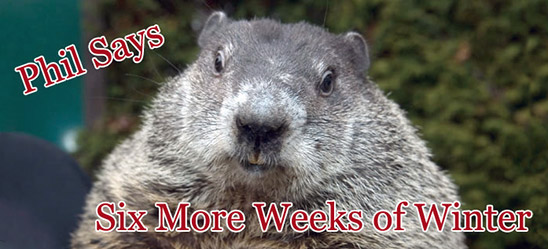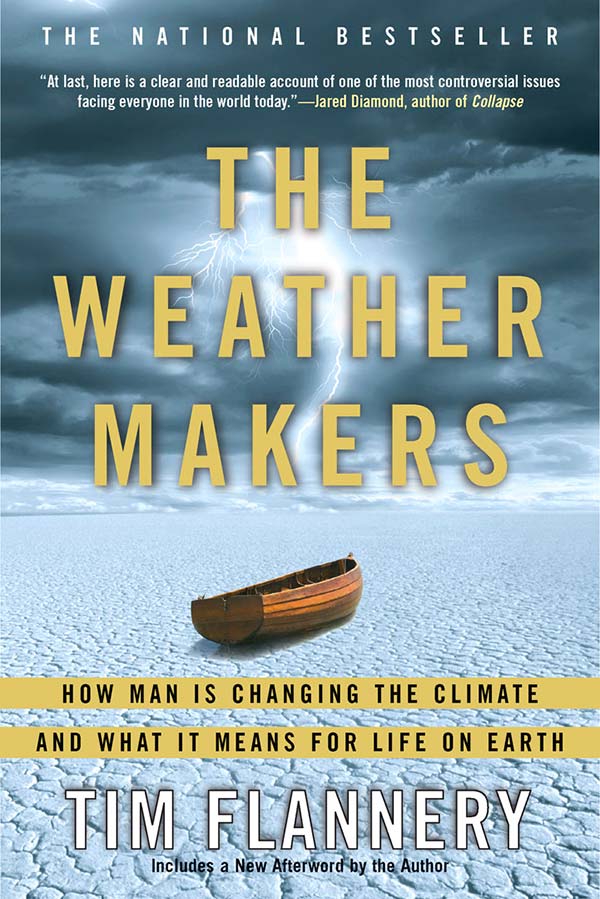In this week’s eSkeptic, William D. Stansfield asks whether groundhogs and swallows are really able to predict the arrival of spring as accurately as reported in the popular press. Stansfield is Emeritus Professor in the Biological Sciences Department at the California Polytechnic State University.

Punxsutawney Phil from the official website of the Punxsutawney Groundhog Club
Punxsutawney Phil and
Animal Weather Predictions
by William D. Stansfield
THERE IS A GROUNDHOG NAMED PUNXSUTAWNEY PHIL living on Gobbler’s Knob, located about two miles east of the town of Punxsutawney, Pennsylvania. On February 2 each year, Phil is said to wake from hibernation and amble outside his den. According to tradition, if he sees his shadow and returns to his den, the country will have six more weeks of winter weather. But if Phil does not see his shadow, spring will be “early” that year. According to the Punxsutawney Groundhog Club, Phil is immortal and has been making these weather prognostications for the last 123 years. Phil and the town of Punxsutawney were immortalized in the 1993 movie Groundhog Day, starring Bill Murray, although the scenes were really filmed in Woodstock, Illinois.
Groundhogs (Marmota monax) are also known as woodchucks. They are common rodents of northern and eastern North America. They eat mainly grasses during the warmer half of the year and build up large amounts of body fat in preparation for up to six months of hibernation sleep during the colder months. Ground squirrels, jumping mice, marmots, and woodchucks are true hibernators whose body temperature drops to almost that of the ambient temperature of their underground burrow or den. Breathing may slow to as few as one breath every five minutes. Groundhogs will awaken if the den temperature drops dangerously low and shiver or move around to raise its body temperature through muscular activity. Other mammals that experience prolonged periods of torpor without true hibernation, such as bears, badgers, opossums, and racoons, reduce their breathing rate significantly, but their body temperature remains almost normal. Hibernating bears can be awakened if sufficiently disturbed. A biologist found this out the hard way when he tried to take a sleeping bear’s rectal temperature with a thermometer.
Actually, Phil is cared for by members of the club year round. Viewing the video of this year’s celebration of Groundhog Day on the club’s website, we see that Phil’s den is a poor imitation of a dead tree stump with a hinged door that is opened by his handler and Phil is pulled forth on February 2 to meet the people who have come to witness the ritual. The time of day is not specified. However, one photograph on the club’s website shows a clock with 10:40 on its face. Phil does not come out of his den on his own. He appears to be fully awake. We do not see Phil placed on the ground where he might cast his shadow. The weather that day in Punxsutawney is not specified. If it was foggy or overcast, Phil would make no shadow.
If the forenoon sun is shining, a groundhog could have a shadow. Taller objects cast longer shadows. Groundhogs typically come out of their burrows and sit upright on their haunches to give them a better chance of spotting potential predators. But if Phil is not allowed to be free of his handlers, he never has the opportunity to cast his best shadow. Longer shadows are cast to the west early in the day. At or near noon, however, an animal built close to the ground, like a groundhog, would cast little or no shadow except directly underneath itself where it would probably not be noticed by the animal. In 2009, a club member speaks for Phil from a written script, saying this year Phil saw his shadow; so he predicts six more weeks of winter weather. The video ends without showing whether Phil goes back into his den on his own or not.
One report claims meteorologists find that on any given day at Punxsutawney the temperature tends to be colder if the day is sunny, and warmer if the day is cloudy. So, if Phil does return to his den on his own, is he responding to the cold weather on a sunny day or is he responding to his shadow, or both, or neither? Winter begins on the winter solstice, about December 22, when the sun is in the zenith over the tropic of Capricorn. The first day of spring occurs about March 21 when the sun crosses the celestial equator on the vernal equinox. These seasonal dates are fixed by the motion of the Earth in its orbit around the sun. So spring officially cannot arrive early or late regardless of what Phil thinks.
The Earth’s axis of rotation is tipped at an angle of about 23.5o from a line perpendicular to the plane of its path around the sun. This tilt of the Earth’s axis is the cause of the seasons. On or near March 21, the sun is directly over the equator. This is called the vernal (spring) equinox, and it marks the beginning of spring in the Northern Hemisphere (autumn in the Southern Hemisphere). I have always wondered why a groundhog that sees its shadow would go back into its burrow for another six weeks. March 16, 2009 is about six weeks after February 2. This is five days earlier than March 21 (the vernal equinox). Was this a consideration of those who concocted the story about the ability of groundhogs to predict the beginning of spring weather?
item of interest…
SOMETIME THIS CENTURY the day will arrive when the human influence on the climate will overwhelm all other natural factors. Dr. Flannery outlines the history of climate change, how it will unfold over the next century, and what we can do to prevent a cataclysmic future, including what every one of us can do right now to reduce deadly CO2 emissions by as much as 70 percent.
ORDER the book
ORDER the lecture
The most vertical (direct) rays of sunshine reach their most northern point on the Earth on or about December 22. This date is called the winter solstice, and it marks the beginning of winter. Because the Earth’s path around the sun is slightly elliptical rather than perfectly circular, the Earth is actually nearest the sun about January 1 (winter in the Northern Hemisphere), and it is farthest away about July 1. Many people do not realize that Earth’s path is elliptical, and even fewer know that during summer in the Northern Hemisphere the Earth is actually farther from the sun than during the winter.
The temperature inside the animal’s burrow doesn’t change as much as the temperature at or near the surface. About every two weeks during hibernation, groundhogs warm up enough to become sluggishly active for a short period of time to check the temperature outside their burrows. It would be unusual if a groundhog came out on the second of February rather than some other date to check the temperature. They might not come out until March. The terms “spring weather” and “winter weather” have not been adequately defined. Winter weather is not necessarily over just because there is a warm day or two in early February.
There are several other sites in the U.S. and Canada where groundhogs are employed to forecast the weather, but Punxsutawney Phil seems to be the most widely reported by the media. Balzac Billy (Alberta, Canada), Buckeye Chuck (Ohio), General Beauregard Lee (Georgia), Shubenacadie (Nova Scotia, Canada), Smith Lake Jake (Alabama), Staten Island Chuck (New York), Sir Walter Wally (North Carolina), and Wiarton Willie (Ottawa, Canada) are some of the other weather forecasters. It has been reported that these groundhogs correctly predicted early spring weather about 37 percent of the time. For the last 112 years, Phil has predicted 14 early springs (13%). Even if a groundhog makes an accurate weather prediction, it stretches credulity to think that the forecast of a groundhog could apply anywhere other than locally; certainly not across the whole lower 48 states and southern Canada. About half the time, my local TV weatherman on the central coast of California seems unable to accurately predict the weather 24 hours in advance as winter turns into spring. I doubt that his long range forecasting is any better than Phil’s.
Another Animal Prognosticator
There is at least one other animal species that is also famous for its alleged ability to exhibit specific behaviors correlated to the arrival of spring. According to legend and the information promulgated by the city and mission of San Juan Capistrano, northern cliff swallows (Petrochelidon pyrrhonota) begin arriving at the Franciscan Mission of San Juan Capistrano (in coastal Southern California) each year on or about March 19, the Feast of St. Joseph. The 19th is at least one day prior to the celestial first day of spring (vernal equinox) that varies from March 20 to March 21. However, according to sources that may be less subject to biased tourist information, these birds usually return to Capistrano sometime between early February and mid-March. It has been suggested that many people do not see the swallows until about March 19 because they simply have not been looking skyward in expectation until then.
These birds spend the North American winter 7,500 miles south in the “sister town” of Goya, Argentina. Here they fatten themselves on insects, spiders, and worms in preparation for their long migration back to California. They begin the return flight from Goya about February 18 and arrive about 30 days later. They do not eat during these migratory flights and spend about 15 hours during daylight in flight, covering about 450 miles per day. The time of the spring flight varies a few days from year to year.
This species is widely distributed over North America and can be found as far north as Alaska and as far east as Nova Scotia. They also can be found in Central America and in several countries in South America east of the Andes Mountains. These birds do not breed while in their southern latitudes. When the various populations begin their migrations north, they gather into large bands. Their various flight paths coalesce at the southern tip of Central America (Panama-Columbia border), continue along the eastern coast of Central America, cross over the Yucatan Peninsula in Mexico, then fan out in all directions over North America toward their summer breeding territories. The group that settles at San Juan Capistrano flies along the shore of Baja California and enters California through the valley of Riverside. In their home territories, the birds feed voraciously to replace their fat stores, they build their mud nests, mate, lay eggs, and rear their young. Around October 23, the swallows gather into bands again and head towards their various winter homes (such as Goya for the San Juan Capistrano population).
Not all bird species migrate annually over well defined routes such as those for the swallows. Relatively few migratory bird species cross the equator. Migratory species probably assure themselves of a richer and more constant supply of food throughout the year if they migrate to more favorable climates. But what factors trigger the mass migrations of the swallows on (or very near) specific dates? Cliff swallows are difficult to rear in captivity, so other species, such as white-throated sparrows and slate-colored juncoes, have been used for research on their breeding cycles. An organism’s “photoperiod” is the cumulative number of daylight hours to which it must be exposed in order to stimulate specific physiological and/or behavioral responses. The photoperiod of swallows is involved in synchronizing the breeding cycle with the various seasons. Perhaps the amount of fat stored in the bird’s body may be part of the trigger for migration. A bird without a “full tank” of fuel for the long migration probably would perish en route. Although the exact physiological mechanisms have not all been discovered, it seems as though a bird in its southern territory is almost able to “count” the number of hours of daylight, and when a threshold total number is attained, the bird is ready to migrate north.
Although the behaviors of groundhogs and swallows are not the precise predictors of spring weather commonly attributed to them in the popular press, they nonetheless deserve our admiration and respect for their adaptability to survive and reproduce in the face of unfavorable environmental conditions.

Space shuttle Endeavour launches on the STS-127 mission to the International Space Station in 2009. (photo credit: NASA)

Eyes to the Sky
For a myriad of reasons, NASA is in the news this week. For an update on everything astronomical, Skepticality is proud to welcome back The Bad Astronomer himself, Dr. Phil Plait (author of the popular books Bad Astronomy, Death from the Skies and his award-winning blog at DiscoverMagazine.com).
Swoopy chats with Phil about this week’s planned launch of the space shuttle Endeavour (one of five final missions marking the retirement of the shuttle fleet by the close of 2010); the surprising recent announcement of President Obama’s plans to increase NASA’s funding but cancel the Constellation program already five years underway; and, Phil’s own tough decision to step down as president of the James Randi Educational Foundation in order to extend his skeptical outreach to a global audience through television.

NEW ON SKEPTICBLOG.ORG
One one-thousand … two one-thousand …
3.8 trillion one-thousand
In this week’s Skepticblog, in light of US President Barack Obama’s unveiling of his new budget for fiscal year 2011, Michael Shermer illustrates just how brobdingnagianly big 3.8 trillion dollars really is.
NEW ON MICHAELSHERMER.COM
Cultivate Your Garden
In his Scientific American column for February, Michael Shermer argues that a lack of control can lead to superstition and he suggests what can be done about it.

Don’t miss this lecture by one of
the greatest minds of our generation…
Jared Diamond
Natural Experiments of History
Sunday, February 28, 2010 at 2 pm, Beckman Auditorium
Book signing to follow the lecture.
Author of the Pulitzer-prize winning Guns, Germs, and Steel and the bestselling work in environmental history Collapse, Jared Diamond reveals for the first time his methodology in the applied use of natural experiments and the comparative method.










